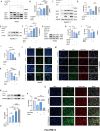p53 enhances elesclomol-Cu-induced cuproptosis in hepatocellular carcinoma via FDXR-mediated FDX1 upregulation
- PMID: 40630211
- PMCID: PMC12234530
- DOI: 10.3389/fonc.2025.1584811
p53 enhances elesclomol-Cu-induced cuproptosis in hepatocellular carcinoma via FDXR-mediated FDX1 upregulation
Abstract
Background: Cuproptosis, a novel cell death pathway mediated by ferredoxin 1 (FDX1) and protein lipoylation, has emerged as a valuable target in cancer therapy. Although the findings of previous research have indicated a potential correlation between p53 and cuproptosis, the precise role and underlying mechanisms of p53 in cuproptosis, particularly within the context of hepatocellular carcinoma (HCC), remain unclear.
Methods: To evaluate cuproptosis, three HCC cell lines (HepG2, PLC/PRF/5, and Hep3B2.1-7) with distinct p53 statuses were treated with elesclomol-Cu. p53 overexpression/knockdown, siRNA-mediated ferredoxin reductase (FDXR)/FDX1 knockdown, and the p53 activators CP-31398 and nutlin-3 were employed to elucidate the associated molecular mechanisms. Cell viability, protein expression [FDX1, dihydrolipoyl transacetylase (DLAT), FDXR], and DLAT oligomerization were assessed via Cell Counting Kit-8 (CCK-8), western blotting, and immunofluorescence analyses. A PLC/PRF/5 xenograft mouse model was used to assess combined the therapeutic efficacy of elesclomol-Cu and CP-31398.
Results: Elesclomol-Cu triggered cuproptosis in HCC cells, as evidenced by a dose-dependent suppression of proliferation, FDX1 upregulation, DLAT oligomerization, and rescue by the copper chelator tetrathiomolybdate (TTM). p53 activation enhanced FDXR expression, promoting FDX1 upregulation and subsequent DLAT oligomerization, thereby sensitizing HCC cells to elesclomol-Cu, whereas FDXR knockdown reversed these effects, demonstrating its role in p53-mediated potentiation of cuproptosis sensitivity. In mutant p53-R249S cells, CP-31398 functioned synergistically with elesclomol-Cu to suppress proliferation. In vivo, elesclomol-Cu and CP-31398 combination therapy significantly reduced tumor growth and Ki67 expression whilst upregulating FDXR levels.
Conclusions: These findings revealed that p53 enhances elesclomol-Cu-induced cuproptosis in HCC via FDXR-mediated FDX1 upregulation. This study provides mechanistic insights into p53's role in cuproptosis and may serve as a basis for targeting copper metabolism in therapeutic strategies for HCC.
Keywords: cuproptosis; dihydrolipoyl transacetylase; elesclomol-Cu; ferredoxin 1; ferredoxin reductase; hepatocellular carcinoma; p53.
Copyright © 2025 Liu, Qu, Li, Sun, Wang, Wang, Bai and Li.
Conflict of interest statement
The authors declare that the research was conducted in the absence of any commercial or financial relationships that could be construed as a potential conflict of interest.
Figures





Similar articles
-
Copper ionophore complex ES-Cu synergizes with quercetin to target FDX1, promote cuproptosis, and reverse lenvatinib resistance in hepatocellular carcinoma cells.J Adv Res. 2025 Sep 1:S2090-1232(25)00681-2. doi: 10.1016/j.jare.2025.08.066. Online ahead of print. J Adv Res. 2025. PMID: 40902896
-
FDX1 facilitates elesclomol-induced cuproptosis and promotes glioblastoma development via transcription factor NFKB1.Biochem Pharmacol. 2025 Jul 25;241:117186. doi: 10.1016/j.bcp.2025.117186. Online ahead of print. Biochem Pharmacol. 2025. PMID: 40716652
-
Engineered RAP-anchored copper-escorting liposomes for FDX1-targeted cuproptosis in glioblastoma therapy.Theranostics. 2025 Jul 2;15(15):7802-7819. doi: 10.7150/thno.115723. eCollection 2025. Theranostics. 2025. PMID: 40756352 Free PMC article.
-
Cuproptosis: a novel therapeutic mechanism in lung cancer.Cancer Cell Int. 2025 Jun 24;25(1):231. doi: 10.1186/s12935-025-03864-1. Cancer Cell Int. 2025. PMID: 40555995 Free PMC article. Review.
-
Copper metabolism and cuproptosis: broad perspectives in the treatment of hepatocellular carcinoma.Front Oncol. 2025 Jul 30;15:1555858. doi: 10.3389/fonc.2025.1555858. eCollection 2025. Front Oncol. 2025. PMID: 40809021 Free PMC article. Review.
References
LinkOut - more resources
Full Text Sources
Research Materials
Miscellaneous

